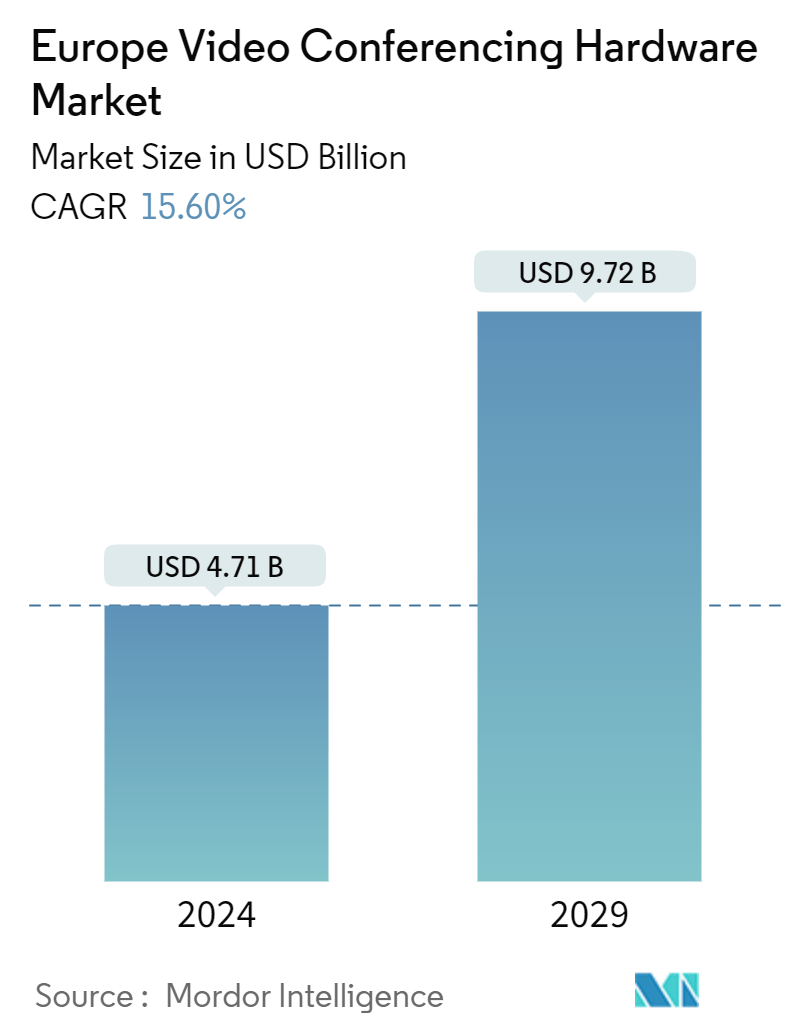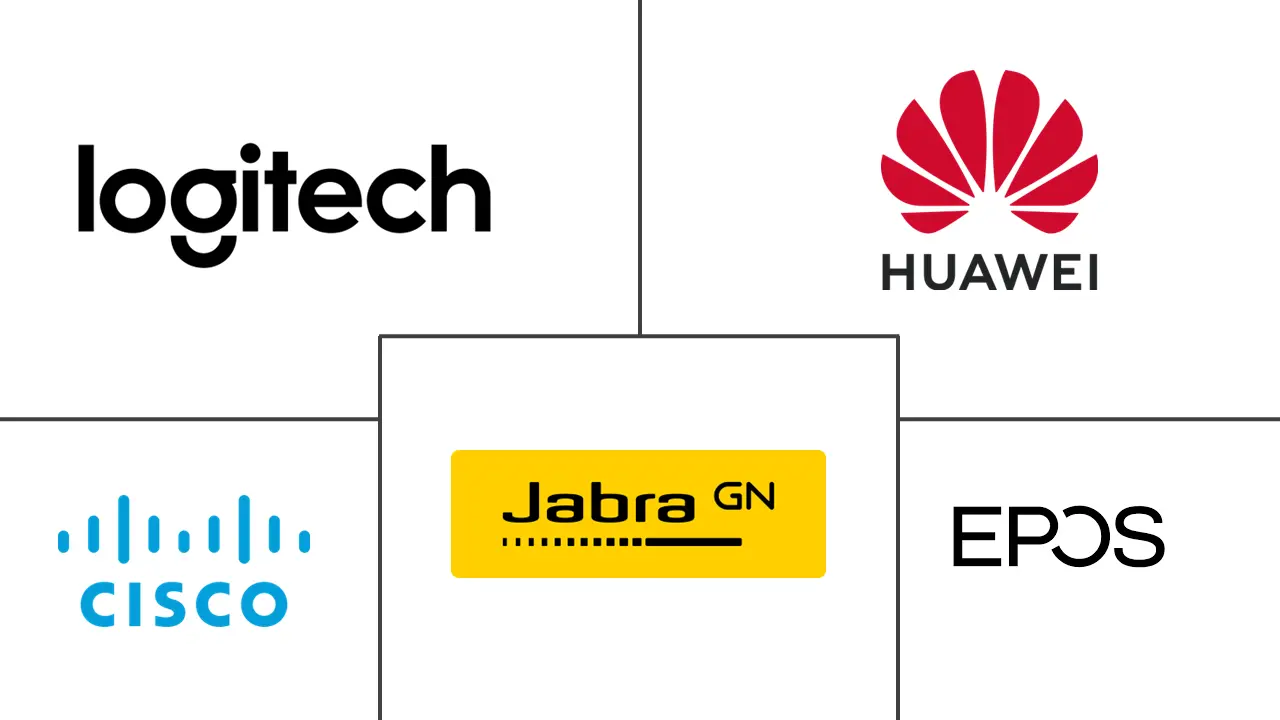Market Size of Europe Video Conferencing Hardware Industry

| Study Period | 2022 - 2029 |
| Base Year For Estimation | 2023 |
| Market Size (2024) | USD 4.71 Billion |
| Market Size (2029) | USD 9.72 Billion |
| CAGR (2024 - 2029) | 15.60 % |
| Market Concentration | High |
Major Players
*Disclaimer: Major Players sorted in no particular order |
Europe Video Conferencing Hardware Market Analysis
The Europe Video Conferencing Hardware Market size is estimated at USD 4.71 billion in 2024, and is expected to reach USD 9.72 billion by 2029, growing at a CAGR of 15.60% during the forecast period (2024-2029).
The European video conferencing hardware market is undergoing drastic change due to changes in work culture and workplaces. The growing demand for real-time and flexible video conferencing devices drives market growth. Technological advancements in hardware such as cameras, MCUs, codec systems, enterprise headsets, and USB-based integrated bars drive the market. Further, the increased adoption of hybrid work culture fuels market growth.
Cameras are vital in video conferencing and remote communication in the digital world. High-resolution cameras are in high demand due to the growing need for remote collaboration solutions and the growth of remote work culture. Major players in the video conferencing market, such as Hikvision, Logitech, Sony, Dahua, and Huawei, are constantly investing in R&D to develop innovative camera solutions with cutting-edge technology to meet consumer demand. Such developments are expected to drive market growth.
The constant innovation and upgradeability of the existing hardware create tremendous market opportunities. The development of MCUs speeded up group meetings by allowing easy integration of inputs from different sources. MCUs ensure that each participant in the video call shares the same collective feed by connecting the various streams of video, audio, and data into a single broadcast. Modern MCUs also include advanced features such as transcoding, which increase their capacity to handle multiple participants with variable codec request bandwidth. Thus, the improved features and hardware capabilities are expected to attract more consumers in the coming years.
According to Eurostat, in 2023, 12% of the employed people worked from home in the European Union compared to 10.2% in 2022. Estonia recorded the highest number of people working from home. The share of work-from-home workers changed broadly between European countries, with 25% of Irish workers working from home in 2022, compared to 1.4% of Romanian workers during the same period. Women mainly work from home compared to men. However, this was reversed in some countries; for example, in Ireland, around 26% of men regularly worked from home in 2022.
Also, the growth of the 5G network further accelerated the adoption of video conferencing solutions as technology helped to reduce latency and increase network speed for the users. Data security concerns and poor audio/video quality or software glitches hinder market growth. Technical issues in audio or video hardware devices will restrict the market growth. In addition, low network bandwidth and connectivity issues with USB cameras, speakers, or microphones may hamper market growth.
The Russia-Ukraine war put pressure on the global supply chain, which significantly hampered electronics production due to the availability of raw materials. Such factors are expected to hinder market growth. Moreover, the increased inflation and economic slowdown across the major European countries decreased consumer spending, resulting in low demand for video conferencing hardware.
Europe Video Conferencing Hardware Industry Segmentation
The study tracks the revenue accrued by various players in the European market selling video conferencing hardware. It also tracks the key market parameters, underlying growth influencers, and major vendors operating in the industry, which will support the market estimations and growth rates during the forecast period. The study further analyses the overall impact of the COVID-19 pandemic aftereffects and other macroeconomic factors in the market. The report’s scope encompasses market sizing and forecasts for the various market segments.
The European video conferencing hardware market is segmented by product (multi control units (MCU), collaboration bars, codec systems, USB cameras, USB-based integrated bars, other bundled kits, enterprise headsets), end user (institutions and commercial spaces), and country (United Kingdom, Germany, France, Italy, and Rest of Europe). The market sizes and forecasts regarding value (USD) for all the above segments are provided.
| By Type of Hardware | |
| Multi Control Units (MCU) | |
| Collaboration Bars | |
| Codec Systems, | |
| USB Cameras | |
| USB-based Integrated Bars | |
| Other Bundled Kits | |
| Enterprise Headsets |
| By End User | |
| Institutions | |
| Commercial Spaces |
| By Country*** | |
| United Kingdom | |
| France | |
| Germany | |
| Italy |
Europe Video Conferencing Hardware Market Size Summary
The European video conferencing hardware market is experiencing significant transformation driven by evolving work cultures and the increasing demand for real-time, flexible communication solutions. Technological advancements in hardware components such as cameras, MCUs, codec systems, enterprise headsets, and USB-based integrated bars are propelling market growth. The shift towards hybrid work environments has further accelerated the adoption of these technologies, as organizations seek to facilitate seamless collaboration between remote and on-site team members. Major industry players like Hikvision, Logitech, Sony, Dahua, and Huawei are investing heavily in research and development to innovate and enhance their offerings, particularly in high-resolution camera solutions, to meet the growing needs of remote collaboration.
The market is also witnessing a surge in demand from educational institutions across Europe, where video conferencing hardware is being integrated to support online and distance learning. Universities and colleges are investing in high-quality audio-visual equipment to enhance the virtual learning experience, with a focus on improving student-teacher communication and engagement. Despite challenges such as data security concerns, technical issues, and economic factors like inflation, the market is poised for substantial growth. The consolidation of the market is evident with leading vendors like Jabra Inc., Cisco Systems Inc., and EPOS continuously expanding their product offerings and strategic partnerships to strengthen their market presence.
Europe Video Conferencing Hardware Market Size - Table of Contents
-
1. MARKET INSIGHTS
-
1.1 Market Overview
-
1.2 Industry Attractiveness - Porter's Five Forces Analysis
-
1.2.1 Threat of New Entrants
-
1.2.2 Bargaining Power of Buyers/Consumers
-
1.2.3 Bargaining Power of Suppliers
-
1.2.4 Threat of Substitute Products
-
1.2.5 Intensity of Competitive Rivalry
-
-
1.3 Impact of COVID-19 Aftereffects and Other Macroeconomic Factors on the Market
-
-
2. MARKET SEGMENTATION
-
2.1 By Type of Hardware
-
2.1.1 Multi Control Units (MCU)
-
2.1.2 Collaboration Bars
-
2.1.3 Codec Systems,
-
2.1.4 USB Cameras
-
2.1.5 USB-based Integrated Bars
-
2.1.6 Other Bundled Kits
-
2.1.7 Enterprise Headsets
-
-
2.2 By End User
-
2.2.1 Institutions
-
2.2.2 Commercial Spaces
-
-
2.3 By Country***
-
2.3.1 United Kingdom
-
2.3.2 France
-
2.3.3 Germany
-
2.3.4 Italy
-
-
Europe Video Conferencing Hardware Market Size FAQs
How big is the Europe Video Conferencing Hardware Market?
The Europe Video Conferencing Hardware Market size is expected to reach USD 4.71 billion in 2024 and grow at a CAGR of 15.60% to reach USD 9.72 billion by 2029.
What is the current Europe Video Conferencing Hardware Market size?
In 2024, the Europe Video Conferencing Hardware Market size is expected to reach USD 4.71 billion.

